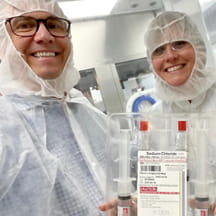James Hoffman, Pharm.D., M.S. and chief patient safety officer at St. Jude Children's Research Hospital recognizes at times in patient safety, leaders tend to try the same tactics over and over. Pharmacogenomics could be a next generation tactic to reducing patient harm.
At the 2019 Quality and Safety in Children's Health Conference, he asked: "What is new that we need to be doing to continue to reduce patient harm? We need to think about strategies we aren't doing today."
What are the leading sources of patient harm?
Medications account for about 27 percent of patient harm. Procedures are the only other recorded data set with more instances of patient harm, at 32 percent.
What is pharmacogenomics?
It's the science of identifying and validating genomic variants that can influence drug response and implementing strategies to use a patient's genomic information to inform treatment decisions.
What is the industry perspective on pharmacogenomics?
There are varying perspectives. Some view it as a way to take science and turn it into practice. Others see it as an area of interest, and then some view it as all hype with no substance in care. However, Hoffman suggests viewing it more as a patient safety strategy than anything else.
How do patient safety and pharmacogenomics relate to one another?
Hoffman says not only does it give the prescribing clinician additional information to proactively select the right medication improving safety and effectiveness of care, but it has potential to increase patient compliance with their medication.
A study of 52,942 patients showed 65 percent would be exposed to one of 56 drugs. Six of those 56 were looked at more closely for adverse events. There were 383 adverse events found, demonstrating a large area of opportunity. Recommending medications that match up with a patient's genomic profile can prevent those adverse events.
How common are the genes for these types of medications?
One study showed that out of 12 commonly tested genes, they matched with 98.5 percent of Caucasian patients and 99.1 percent of African Americans. Sequencing data has demonstrated 96.19 percent of all genomic samples had actionable variants.
How is St. Jude Children's Hospital using pharmacogenomics?
Through one of two ways: PG4KDS and Clinical Pharmacogenetics Implementation Consortium (CPIC). PG4KDS is a program specifically for St. Jude patients. CPIC is an international group dedicated to furthering the use of pharmacogenomics.
What does PG4KDS do for St. Jude patients?
PG4KDS works to make pharmacogenomics available preemptively for use in routine patient care. It's more of a proactive approach. Rather than waiting for other medications to fail to then conduct genomic testing, PG4KDS gathers blood samples on the front end to understand a patient's genomic makeup and better recommend medications. Nearly every patient at St. Jude is approached for participation. Enrollment into the program is about 95 to 97 percent.
In 2011, St. Jude started genotyping with just two genes and two medications. By the end of 2018, there were eight genes and 25 drugs. Hoffman notes it's a larger undertaking to add a new gene than a new drug.
What is the CPIC's role in pharmacogenomics?
As of January 2019, CPIC has 320 members from 29 countries. The National Institutes of Health (NIH) and U.S. Food and Drug Administration (FDA) are both part of the organization. There's a specific informatics workgroup with 30 members from 25 organizations. As a whole, CPIC offers guidelines to help clinicians not determine whether to order genomic testing, but instead how to use the results to optimize drug therapy.


